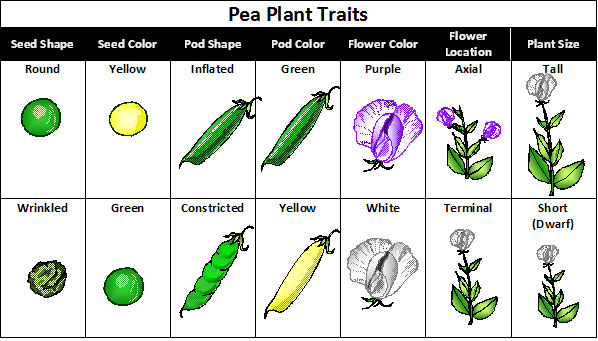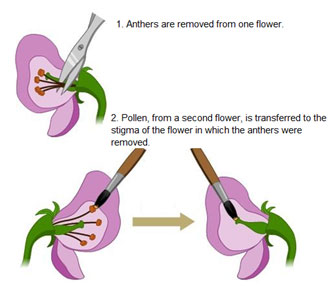
Source: Pea Plant Characteristics, Mariana Ruiz, Wikimedia Commons
Many biologists, researchers, and students have been curious as to why Mendel chose to use pea plants in his genetics research. There are several reasons why Mendel chose to work with pea plants.
First, pea plants grow and reproduce quickly. This helped Mendel study many generations over a short period of time. Second, pea plants are easily bred. And third, pea plants have a variety of characteristics, or traits. A trait is a specific characteristic such as seed shape or flower color.
Mendel studied seven traits shown in the image below.

Source: Pea Plant Characteristics, Mariana Ruiz, Wikimedia Commons
In some plants, called angiosperms, the flower is the reproductive structure. Flowers have both the female and male reproductive structures.
The female reproductive structures are called carpels. In most flowers, the carpels are fused together to form a pistil. The pistil is made up of three parts: the stigma, style, and ovary. The male reproductive structure is called a stamen. Each stamen has two parts: the anther and the filament.
![]() Click on each word in the image below to learn more about the structure of a flower.
Click on each word in the image below to learn more about the structure of a flower.

Source: Self Pollination, Kids Encyclopedia Britannica
Pea plants are normally self-pollinating, which means the pollen fertilizes the egg of the same flower. The image to the right shows what happens during self-pollination. Mendel's pea plants were "true breeding," meaning if the plants self-pollinated, the plants would always produce offspring with the same traits as the parents.

Source: Adapted From: Cross-Pollination, The University of Waikato
Mendel did not allow the plants in his garden to self-pollinate. Instead, he cross-pollinated the plants. The diagram to the left shows cross-pollination.
By using cross-pollination, Mendel was able to control what traits were crossed.